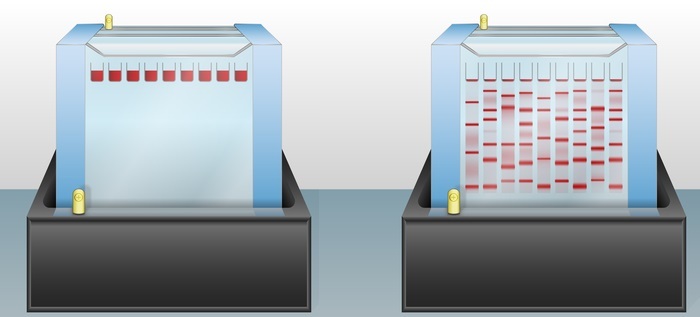
 Data Structure
Data Structure Networking
Networking RDBMS
RDBMS Operating System
Operating System Java
Java MS Excel
MS Excel iOS
iOS HTML
HTML CSS
CSS Android
Android Python
Python C Programming
C Programming C++
C++ C#
C# MongoDB
MongoDB MySQL
MySQL Javascript
Javascript PHP
PHP
- Selected Reading
- UPSC IAS Exams Notes
- Developer's Best Practices
- Questions and Answers
- Effective Resume Writing
- HR Interview Questions
- Computer Glossary
- Who is Who
What is Gel Electrophoresis
Introduction
Gel electrophoresis is a widely used analytical technique in molecular biology and biochemistry that allows the separation of DNA, RNA, and protein molecules based on their size, charge, and other physical properties.
It is a simple and effective way to isolate and purify specific molecules from complex mixtures, such as DNA fragments, RNA transcripts, or proteins. Gel electrophoresis is used in a variety of applications, including genetic research, medical diagnostics, and biotechnology.

Herewith is a comprehensive overview of gel electrophoresis, including its definition, principle, steps, and uses.
Definition of Gel Electrophoresis
Gel electrophoresis is a laboratory technique used to separate and analyse DNA, RNA, and protein molecules based on their size, charge, and other physical properties. It involves placing the sample to be analysed on a porous gel matrix, applying an electric field, and then allowing the molecules to migrate through the gel matrix.
The molecules are separated based on their size, with smaller molecules moving faster through the gel than larger ones.
The technique was first developed in the 1940s and 1950s by biochemists Arne Tiselius and Archer Martin. Since then, gel electrophoresis has become an essential tool in molecular biology and biochemistry, used to analyse and purify a wide range of biomolecules.
Principle of Gel Electrophoresis
The principle of gel electrophoresis is based on the fact that DNA, RNA, and protein molecules are negatively charged due to the presence of phosphate groups and amino acid residues.
When placed in an electric field, these molecules will migrate towards the positively charged electrode, with the rate of migration dependent on the size and charge of the molecule. The gel matrix used in gel electrophoresis is typically made from agarose or polyacrylamide.
These materials form a porous network that allows the molecules to migrate through the gel matrix based on their size. Agarose gels are commonly used for separating DNA fragments, while polyacrylamide gels are used for separating proteins and small nucleic acids, such as RNA.

The sample to be analysed is prepared by mixing the biomolecules with a loading buffer, which typically contains a tracking dye to help monitor the progress of the electrophoresis, as well as a denaturing agent to ensure that the molecules are uniformly negatively charged.
The sample is then loaded onto the gel matrix, and an electric field is applied across the gel using a power supply.
The molecules migrate through the gel matrix towards the positively charged electrode, with smaller molecules moving faster through the gel than larger ones. The migration distance of each molecule is proportional to its size, with smaller molecules migrating further through the gel than larger ones.
The separated molecules can then be visualized and analysed using a variety of techniques, such as staining with ethidium bromide for DNA or silver staining for proteins. The separated molecules can also be extracted from the gel matrix for further analysis or purification.
Steps in Gel Electrophoresis
The following are the general steps involved in gel electrophoresis ?
Prepare The Gel Matrix
The gel matrix is prepared by dissolving agarose or polyacrylamide in a buffer solution, such as TBE or TG-SDS. The gel matrix is poured into a mould and allowed to solidify, creating a porous gel matrix.
Prepare The Sample
The sample to be analysed is prepared by mixing the biomolecules with a loading buffer, which typically contains a tracking dye to help monitor the progress of the electrophoresis, as well as a denaturing agent to ensure that the molecules are uniformly negatively charged.
Load The Sample
The prepared sample is then loaded onto the gel matrix using a micropipette. Care must be taken to load the sample evenly and not to overload the gel, as this can cause distortion of the separated bands.
Apply The Electric Field
The gel is placed in an electrophoresis chamber and covered with a buffer solution. The electrodes are connected to a power supply, and an electric field is applied across the gel. The electric field causes the negatively charged biomolecules to migrate towards the positively charged electrode.
Monitor The Progress of Electrophoresis
The progress of electrophoresis is monitored by observing the migration of the tracking dye through the gel matrix. The rate of migration of the biomolecules can also be monitored by periodically stopping the electrophoresis and staining the gel with a specific dye, such as ethidium bromide for DNA or silver stain for proteins.
Extract The Separated Molecules
Once the electrophoresis is complete, the separated molecules can be visualized and analysed using a variety of techniques, such as staining with ethidium bromide for DNA or silver staining for proteins. The separated molecules can also be extracted from the gel matrix for further analysis or purification.
Uses of Gel Electrophoresis
Gel electrophoresis is a versatile technique that has a wide range of uses in molecular biology and biochemistry. Some of the most common uses of gel electrophoresis include ?
DNA Fragment Analysis
Gel electrophoresis is commonly used to separate and analyse DNA fragments of varying sizes. This is particularly useful in genetic research, where scientists can use gel electrophoresis to analyse DNA samples for variations and mutations.
RNA Transcript Analysis
Gel electrophoresis can also be used to separate and analyse RNA transcripts of varying sizes. This is particularly useful in gene expression studies, where scientists can use gel electrophoresis to analyse the levels of different RNA transcripts in cells or tissues.
Protein Analysis
Gel electrophoresis can be used to separate and analyse proteins based on their size and charge. This is particularly useful in protein purification and characterization, where scientists can use gel electrophoresis to isolate and purify specific proteins from complex mixtures.
Medical Diagnostics
Gel electrophoresis is also used in medical diagnostics, particularly in the diagnosis of genetic disorders. For example, gel electrophoresis can be used to analyse the haemoglobin molecules in blood samples, allowing doctors to diagnose hemoglobinopathies such as sickle cell anaemia.

What Information Could We Gel from The Article
Gel electrophoresis is a powerful analytical technique that allows the separation and analysis of biomolecules based on their size, charge, and other physical properties.
It is a versatile and widely used technique in molecular biology and biochemistry, with a range of applications in genetic research, medical diagnostics, and biotechnology.
By understanding the principles and steps involved in gel electrophoresis, scientists can use this technique to isolate and purify specific biomolecules, analyse their properties, and gain a deeper understanding of the fundamental processes of life.

